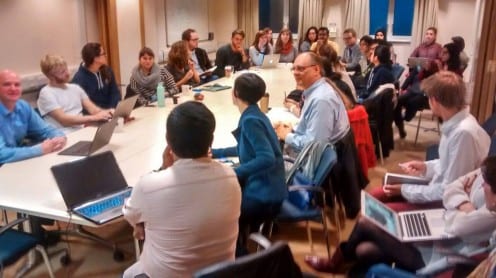A talk at Oxford Internet Institute
By Xin Yuan Wang, on 18 November 2014
by Shriram and Xinyuan

Our research Shriram and Xinyuan giving an talk about social media in India and China at Oxford Internet Institute
It is always good practice to exchange knowledge and ideas with scholars from other fields, as it adds immense value and vision to the research at hand. New Media and Social Media are fields that attract scholars from various other areas of study. The bridging of interdisciplinary ideas that this area of research induces is phenomenal. For example, while social media can be approached from an anthropological point of view, it can at the same time also be approached from a Big Data perspective. In a previous blog post Xinyuan talked about the difference between ‘Big Data’ and digital ethnography.
A couple of weeks ago, two of our researchers (Shriram and Xinyuan) were invited by Professor Ralph Schroeder, a Big Data theorist, from the Oxford Internet Institute (OII) to give a talk on social media in China and India, from an anthropological perspective. This opportunity, which is one of our earliest since our return from our intense 15 months of fieldwork provided great value in understanding and evaluating aspects related to disseminating our research results.
One of our first significant points of contribution was to address the need to study social media in a more traditional anthropological way. This also flowed from the strength of ethnographic evidence that the nine field sites generated over the last 15 months. Ethnographic evidence needs to be presented in a context based ‘thick description’, which anthropology does, allowing researchers present the field site in a rich descriptive and detailed format. This allows the readers/audience understand the situation/context better. The process of communicating such detailed description also brought us another opportunity to transition to a multimedia based approach. Xinyuan showed a 4.5 mins documentary film clip about her field site, Good Path town, a small factory town in southeastern China and the way she did ethnography among Chinese rural migrants who work and live in the factory town as factory workers. The result of using a visual platform to describe one’s field site was extremely positive. When the audience really saw the population and the field in the short clip, the subject no longer stayed as alienated or abstract but became far more humanized and engaging. The positive feedback received has also further encouraged us in our long-term dissemination plan for the project, which also involves a multimedia approach to report on our analyses and findings.
The discussion section was also inspiring. The questions varied from censorship in China to the influence of gender in the use of social media in India; and a few questions touched the very core issue of this comparative project, which was on how to draw conclusions from the ethnography of nine different sites.
Even from the two field sites (India and China), let alone the total nine field sites of the whole project, our audience had already strongly acknowledged the huge differences in the way people use social media as well as the impact of social media usage in local peoples’ daily life. Though the presentations were not intended to be comparative, the format in which they were delivered played a role in giving rise to a few interesting questions that leaned towards a comparison of general issues between China and India. For example: after listening to our presentations, students found that the use of social media in India was strongly influenced by the reality of offline life, however in China among Chinese rural migrants, social media offered a platform where people can simply set up a new world where they can enjoy an ideal life where their offline lives (including their social status are largely irrelevant. Although it’s always risky to over-generalize claims of totally different uses of social media by lower socio-economic groups in India and China, the ethnographic evidence gathered from our 15 months field research allowed our study to showcase the diversity of social media usage in different cultures and societies. Social media itself is by no means a unified or universal concept and its meanings are way more diverse than we can imagine. In short, this opportunity helped both the parties (OII and GSMIS scholars) to explore and understand social media in a much deeper context through an anthropological perspective that is contextually and fieldwork based.
 Close
Close









